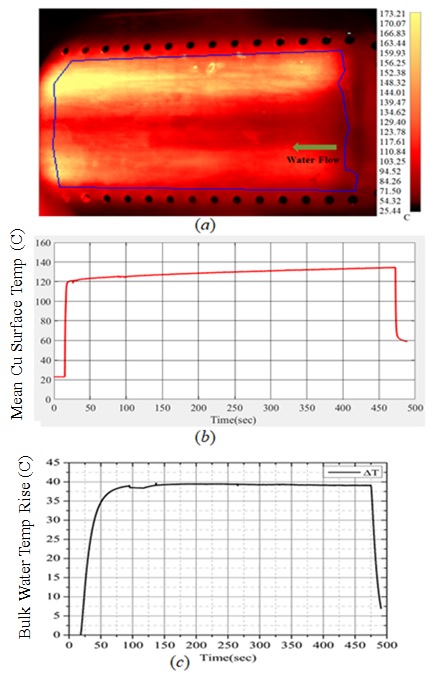Speaker
Description
The ion source of IPR NBI system is positive hydrogen ion based JET PINI multipole bucket type plasma source. One of its critical components is water cooled Back Plate (BP) shown in fig.1 (inset) 1. The average heat load on BP is 2 MW/m^2. Assembly of back plate consists of OFHC copper cooling plate of size 588×318×4 mm^3 with 35 inner and 8 outer cooling grooves each of size 4+0.1×1.8+0.2 mm^2 is vacuum brazed with SS304L magnet positioning plate of size 667×397×27 mm^3. The magnet positioning plate consists of number of grooves for providing house for permanent magnets (SmCo5) arranged in checkerboard configuration for better confinement of plasma. Cooling water manifolds and gas manifold are welded to the magnet positioning plate. SS304L plate of 2 mm thick called magnet cover plate is used to hold permanent magnets in positions. To remove above mentioned heat load, BP is designed for forced convection water cooling with flow velocity inside cooling channels is 8 m/s and heat transfer coefficient is 28 kW/m^2 C. Due to the complexity in fabrication and technical challenges, especially from point of sustainability of large area vacuum brazing under average heat flux of 2 MW/m^2 few company worldwide manufactured BP. An Indian Industry, Hind High Vacuum (HHV) Co. Pvt. Ltd. Bangalore has successfully fabricated one BP. Test result of vacuum brazed sample shows that brazed joint strength is 100 MPa. Assembled BP is pressurized with 16 bar demineralized water for 30 minutes and test is repeated for 5 times. Then vacuum compatibility test of BP done with 16 bar He pressure and leak rate is 10^-9 Tl/s. Performance test of BP is carried out at IPR High Heat Flux Test Facility (HHFTF). The experimental set up is depicted in fig.1.

Back plate is hold vertically with fixture inside D chamber maintained at base pressure of 2.4 × 10-4 mbar. Electron Beams (EB) of pulse length 458 sec is scanned on copper cooling plate surface of size 200× 400 mm^2 (shown in inset in fig.1). The deposited EB power is 200 kW at 45 kV. This gives uniform power load of 2.5 MW/m^2 on the surface of cooling plate. 60 LPM demineralized inlet water at 35 C is supplied to the cooling plate through manifolds at 8.2 bar inlet pressure and flows from right to left shown by arrow in fig. 2(a).

Surface temperature of the copper cooling plate is measured by IR camera shown in fig. 2(a). The IR image of the plate shows cooler temperature region at the middle region (shown in dark shade) and hotter region near edge where feed-through holes are present. It can also be seen that middle of RHS temperature is less in comparison to other region. These distinct temperature regions are due to the fact that water at 35 C is entered through inlet manifold connected to middle of RHS common manifold (not shown) and distributed in 35 cooling channels and flows towards LHS. Due to hydraulic friction cooler water flows into middle cooling channels w.r.t. edge cooling channels. This water flow difference makes cool temperature region in comparison to edge and confirm the IR observation. The steady copper surface temperature (Ts) is 134 C shown in fig. 2(b). Bulk water temperature rise is 40 C shown in fig. 2(c). Experimental chamber pressure during experiment remains constant and no water leakage from BP is observed. After completion of high heat flux test, back plate is taken out from EB chamber and water is removed. Then copper cooling plate is heated to 50oC by hot blower and purged with dry air for complete removal of water from cooling channels. Then leak test is done and result shows the leak rate is 1.1×10^-8 T-l/s. This high heat flux experiment established reliability of back plate (a component of PINI ion source) for long pulse operation. This test is also validates engineering design and fabrication route. The same can be used for fabrication of other high heat flux component required for fusion device.
Reference
1 P. K. Jayakumar et al, Fusion Technology 1 (1998) 419 - 422.
| Affiliation | Institute for Plasma Research |
|---|---|
| Country or International Organization | India |
